Murray Hill, Manhattan
Murray Hill is a neighborhood on the east side of Manhattan in New York City. Murray Hill is generally bordered to the east by the East River or Kips Bay and to the west by Midtown Manhattan, though the exact boundaries are highly disputed.
Murray Hill | |
|---|---|
 Row houses in the Murray Hill Historic District | |
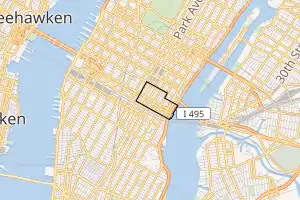
Location in New York City | |
| Coordinates: 40.748°N 73.978°W | |
| Country | |
| State | |
| City | New York City |
| Borough | Manhattan |
| Community District | Manhattan 6[1] |
| Area | |
| • Total | 0.64 km2 (0.249 sq mi) |
| Population (2010)[2] | |
| • Total | 10,864 |
| • Density | 17,000/km2 (44,000/sq mi) |
| Ethnicity | |
| • White | 66.6% |
| • Asian | 16.2 |
| • Hispanic | 9.9 |
| • Black | 4.8 |
| • Others | 2.5 |
| Economics | |
| • Median income | $117,677 |
| Time zone | UTC−5 (Eastern) |
| • Summer (DST) | UTC−4 (EDT) |
| ZIP Codes | 10016, 10017 |
| Area code | 212, 332, 646, and 917 |
Murray Hill was named after Robert Murray, the head of the Murray family, a mercantile family that settled in the area in the 18th century. The Murray property was located on a steep glacial hill that peaked between Lexington Avenue and Broadway. Through the 19th century, Murray Hill was relatively isolated from the rest of New York City, which at the time was centered in lower Manhattan. Murray Hill became an upscale neighborhood during the 20th century. Today, it contains several cultural institutions, as well as missions and consulates to the nearby United Nations headquarters.
Murray Hill is part of Manhattan Community District 6, and its primary ZIP Codes are 10016 and 10017.[1] It is patrolled by the 17th Precinct of the New York City Police Department.
Geography
According to the Murray Hill Neighborhood Association (formerly the Murray Hill Committee), the neighborhood encompasses the 10016 zip code—running from 40th Street down to roughly 27th Street, and from Fifth Avenue to the East River.[4][5][6] By this definition, Murray Hill overlaps with Rose Hill, which is also known as Curry Hill and Little India.[7] This section of Murray Hill was formerly also known as Little Armenia.[8]
The city's Landmarks Preservation Commission has described Murray Hill's boundaries as roughly 34th Street on the south, 40th Street on the north, Fifth Avenue on the west, and Third Avenue on the east.[9] The city's Planning Department has described the boundaries as roughly East 40th Street to the north, Second Avenue to the east, 34th Street to the south, and Madison Avenue to the west.[10]
For its entry on Murray Hill, the American Institute of Architects' AIA Guide to New York City uses the area from East 32nd Street north to roughly East 40th Street, and from Third Avenue west to roughly Madison Avenue. In AIA Guide, Murray Hill abuts Midtown to the north and west, Kips Bay to the east, and Rose Hill to the south.[11]
Manhattan Community Board 6—of which Murray Hill is part—has defined the boundaries as East 34th Street to the south, East 40th Street to the north, Madison Avenue to the west, and East River to the east.[12]
The New York Times states that commonly used boundaries of Murray Hill are East 34th Street to the south, East 42nd Street to the north, Madison Avenue the west, and the East River to the east. Additionally, "the younger, more bar-centric area south of the neighborhood in the upper 20s and lower 30s" is also sometimes held to be part of Murray Hill.[13]
History
Eighteenth century
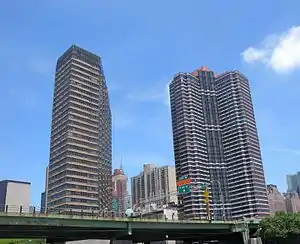
Murray Hill derives its name from the Murray family, 18th-century Quaker merchants mainly concerned with shipping and overseas trade. Robert Murray (1721–1786), the family patriarch, was born in County Armagh, Ireland, immigrated to Pennsylvania in 1732, and came to New York City in 1753 after a short residence in North Carolina. He quickly established himself as a merchant and eventually owned more shipping tonnage than any other New Yorker. About 1762 Murray rented land from the city for a large house and farm. His house, which he named Inclenberg (or Belmont), but which was often called Murray Hill, was built on a since-leveled hill at what is today Park Avenue and 36th Street. The great square house was approached by an avenue of mixed trees leading from the Boston Post Road;[14] it was flanked on three sides with verandas—or “piazzas” as they were called in New York—and commanded views of the East River over Kips Bay. The total area was just over 29 acres (120,000 m2). The farm began a few feet south of modern-day 33rd Street and extended north to the middle of the block between 38th and 39th Streets. At the southern end, the plot was narrow, but at the northern end it extended from approximately Lexington Avenue to a spot between Madison and Fifth Avenues.[15]
The Inclenberg was an abrupt, steep-sided mound of glacial till typical of Manhattan Island's still-unmodified post-glacial terrain: this "hill of the rudest and most heterogeneous mixture of stone and gravel and boulders, cemented together into a matrix of almost impenetrable density existed, crowning the underlying schist... It had a natural rise from 34th Street, sinking towards 42nd Street and reaching from Lexington Avenue to Broadway."[16] Such a soil would have been unsuitable for farming; instead the house, like the other grand projects created by distinguished residents upon Manhattan's prominent rises of ground[17] had other uses: "although some of these estates grew crops for profit," the historians of New York Edwin G. Burrows and Mike Wallace observe,[18] "their primary purpose—besides providing refuge from epidemics—was to serve as theaters of refinement".
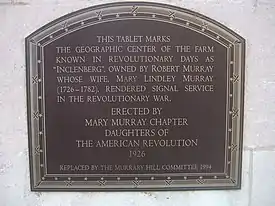
Mary Lindley Murray is credited with delaying William Howe and his army during General Washington's retreat from New York following the British landing at Kip's Bay, September 15, 1776. As the story goes, Mrs. Robert Murray, the mother of Lindley and John, invited the officers to tea[19] at her mansion of Inclenberg and succeeded in delaying the British troops for a period sufficient to allow a successful American retreat.[12][20][21] She is said by Rev. T. Dewitt Talmage to have saved American independence by detaining Lord Howe long enough to permit Israel Putnam to pass up the Greenwich road from the city and join the forces of George Washington in the north end of the island, before Howe was able to overtake him. This dilatory action saved 3,500 men, who would have otherwise been cut off and captured.[21]
James Thacher, M.D., a gossipy surgeon with the Continental Army, kept a journal that is one of the prime sources of information about the military happenings of the times. In an entry for September 20, Thacher tells the story as follows: "The British generals...repaired to the house of a Mr. Robert Murray, a Quaker and friend of our cause; Mrs. Murray treated them with cake and wine, and they were induced to tarry two hours or more, Governor Tryon frequently joking her about her American friends. By this happy incident general Putnam, by continuing his march, escaped...It has since become almost a common saying among our officers, that Mrs. Murray saved this part of the American army."[22]
The most famous member of the family was the oldest child, Lindley Murray (1745–1826). A New York lawyer, he was forced into exile after the Revolution as a loyalist. In England, Lindley wrote 11 school textbooks which had their greatest success in the new United States, partly because no international copyright existed and the books could be reprinted without royalties. Some 16 million copies of Murray's books were sold in America. His English Reader was extremely popular for readers in the United States from 1815 into the 1840s.
Nineteenth century
.jpg.webp)
During the 19th century, this neighborhood was "uptown" with the city ending with the reservoir at Fifth Avenue and 42nd Street covering what today is the New York Public Library Main Branch and Bryant Park. To the north was for the most part farmland. A stream called t'Oude Wrack (Dutch for "Old Wreck") ran across the area, emptying into Sunfish Pond, located at the present-day Park Avenue South and 31st Street in Kips Bay. The stream originated at what is now Broadway and 44th Street in the middle of Times Square.[23] A glue factory polluted Sunfish Pond heavily during the 1820s, and it was infilled in 1839 after most of its water was used to extinguish a fire at the New York House of Refuge.[23]
In the bitter winter of 1808 during the embargo that closed New York harbor, an innovative work relief program kept out-of-work dock workers busy reducing the height of Murray Hill;[24] between twenty and forty feet were sliced off its summit and used for fill.[25] In 1833 the railroad cut was begun, to carry the New York and Harlem Rail Road through Murray Hill; the route under the most prominent obstacle in its right-of-way was opened on May 1, 1834;[26] then the locomotives, which had met the horse-cars that ran through the city's streets at the station at 27th Street, could pass the reduced hill; by an act of 1850 the city permitted to roof over the cut for the passage of steam locomotives. This Park Avenue Tunnel, enlarged and relined, has been devoted to automobile traffic since 1937.[26]
In mid-century, the rich temporarily, and the upper middle class more permanently, filled the brownstone row houses that filled Murray Hill's streets. The Brick Presbyterian Church followed its congregation; after selling its site facing City Hall Park, it rebuilt in 1857 closer to its congregation, on the smoothed brow of Murray Hill, at Fifth Avenue and 37th Street.[27] However, when J. P. Morgan built his conservative brownstone free-standing mansion in 1882 on Madison Avenue at 36th Street, which is today a part of The Morgan Library & Museum, it was considered a fashionable but slightly old-fashioned address,[28] as the rich were filling Fifth Avenue with palaces as far as Central Park. Instead stylish merchandising was changing the neighborhood; Madison Square Park, at this time considered a part of Murray Hill, was bordered by the fashionable ladies' shops of the day on Fifth Avenue.
Late twentieth century
For much of the 20th century, Murray Hill was a quiet and rather formal place, with many wealthy older residents. In 1905, Franklin and Eleanor Roosevelt lived close by Franklin's mother Sara Roosevelt in the Murray Hill neighborhood.[29]
Since the late 1990s, many young people in their twenties have moved to the area from the suburbs of New York. As reported in the New York Times in 2011, "...recent college graduates can find themselves among fellow alumni, meet up for familiar drinking rituals and flock to the frozen-yogurt shops and sushi bars that help them stay fit and find a mate for the next stage of life".[30] On weekends, the raucous restaurant-and-bar scene along Third Avenue, beyond the traditional eastern limits of Murray Hill, particularly reflects this change. In the late 1990s, Murray Hill began to attract an influx of young college graduates, leading to a "work-hard, play-hard" atmosphere, which has since been referenced in several media sources such as The New York Times[30] and New York Post. Though housing in the neighborhood is slightly cheaper than in fashionable nearby parts of Manhattan, prices for apartments here rose greatly during the boom of the late 1990s and early 2000s—as much as 500 percent in a decade.
The eastern part of Murray Hill, between FDR Drive and First Avenue from 35th-36th and 38th-41st Streets, formerly contained Consolidated Edison's Waterside power plant until 1999, when the lots were placed for sale.[31] The billionaire developer Sheldon Solow purchased these plots in 2000 and demolished the plant in anticipation of the construction of a multi-building complex on the site. However, these plans stalled with the financial crisis of 2007–2008, and the land lay unused.[32] Solow later sold the 35th-36th Streets plot, and the American Copper Buildings were built on that site, opening in 2017–2018.[33] As of 2018, the 38th-41st Streets plot was still unused, but Solow intended to construct a four-building condo and office complex on that site.[34][35]
Demographics
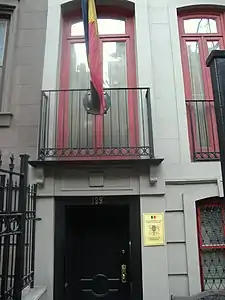
For census purposes, the New York City government classifies Murray Hill as part of a larger neighborhood tabulation area called Murray Hill-Kips Bay.[36] Based on data from the 2010 United States Census, the population of Murray Hill-Kips Bay was 50,742, a change of 2,323 (4.6%) from the 48,419 counted in 2000. Covering an area of 334.93 acres (135.54 ha), the neighborhood had a population density of 151.5 inhabitants per acre (97,000/sq mi; 37,400/km2).[37] The racial makeup of the neighborhood was 66.6% (33,818) White, 4.8% (2,423) African American, 0.1% (55) Native American, 16.2% (8,233) Asian, 0% (16) Pacific Islander, 0.4% (181) from other races, and 2% (1,008) from two or more races. Hispanic or Latino of any race were 9.9% (5,008) of the population.[3]
The entirety of Community District 6, which comprises Murray Hill and Stuyvesant Town, had 53,120 inhabitants as of NYC Health's 2018 Community Health Profile, with an average life expectancy of 84.8 years.[38]:2, 20 This is higher than the median life expectancy of 81.2 for all New York City neighborhoods.[39]:53 (PDF p. 84)[40] Most inhabitants are adults: a plurality (45%) are between the ages of 25–44, while 22% are between 45 and 64, and 13% are 65 or older. The ratio of youth and college-aged residents was lower, at 7% and 12% respectively.[38]:2
As of 2017, the median household income in Community District 6 was $112,383,[41] though the median income in Murray Hill individually was $117,677.[2] In 2018, an estimated 10% of Murray Hill and Stuyvesant Town residents lived in poverty, compared to 14% in all of Manhattan and 20% in all of New York City. One in twenty-five residents (4%) were unemployed, compared to 7% in Manhattan and 9% in New York City. Rent burden, or the percentage of residents who have difficulty paying their rent, is 42% in Murray Hill and Stuyvesant Town, compared to the boroughwide and citywide rates of 45% and 51% respectively. Based on this calculation, as of 2018, Murray Hill and Stuyvesant Town are considered to be high-income relative to the rest of the city and not gentrifying.[38]:7
Structures
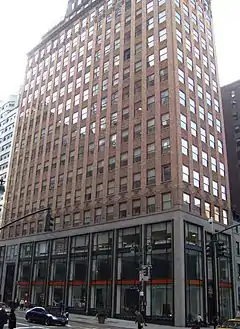
The neighborhood is home to St. Vartan Armenian Cathedral, Stern College for Women of Yeshiva University, The Morgan Library & Museum, Scandinavia House–The Nordic Center in America, The Mexican Cultural Institute of New York, and a historically notable private institution, the Union League Club of New York. Just west of Murray Hill is 10 East 40th Street, an example of art deco architecture. Official landmarks in Murray Hill include the Daily News Building, the Madison Belmont Building, and the Socony–Mobil Building, all designated by the New York City Landmarks Preservation Commission.[42]
On January 29, 2008, the Whitney Museum of American Art branch gallery at what had been the Philip Morris headquarters opposite Grand Central Terminal closed after a 25-year run. For around fifty years the neighborhood has been home to National Review, the conservative journal of opinion founded by William F. Buckley, Jr., most of that time at 150 East 35th Street, currently at 215 Lexington Avenue at 33rd Street. 150 East 35th Street was purchased by Yeshiva University.
Economy
The defense contractor L3 Technologies has its headquarters in Murray Hill.[43] Sumitomo Corporation operates its New York Office, the headquarters of the corporation's United States operations, in the same building as the headquarters of L-3. Industries supported by the office include Aerospace and Defense, Agricultural Commodities, Agrochemicals, Business Investment, Chemicals, Fertilizer, Information Technology, Latin American Operations, Living Related Products, Media and IT Venture Group, Meat Products, Presidio Venture Partners, Ship, Real Estate, Transportation Systems and Equipment, and Tubular Products.[44] China Airlines operates its New York branch office on Third Avenue.[45][46]
American Airlines opened its headquarters at 633 Third Avenue in 1975.[47] Three years later, American announced that it would move its headquarters to a site at Dallas/Fort Worth International Airport the following year, in an act that New York City mayor Ed Koch called a "betrayal" of New York City.[48]
Diplomatic missions
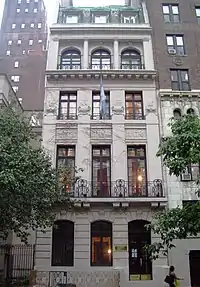
Due to the proximity of the headquarters of the United Nations and the availability of old mansions, many countries operate diplomatic missions and consulates in Murray Hill, including:
- The Consulate-General of Mexico in New York, at 27 East 39th Street (10016).[49]
- The Consulate-General of South Africa in New York, at 333 East 38th Street (10016).[50]
- The Consulate-General of the Republic of Poland in New York, at 233 Madison Avenue (10016).[51]
Missions to the United Nations in Murray Hill include:[52]
- Afghanistan
- Armenia
- Austria
- Benin
- China[53]
- Cuba
- El Salvador
- Estonia
- Fiji
- Guatemala
- Guinea
- India
- Indonesia
- Iran
- Lesotho
- Liechtenstein
- Malta
- Mauritania
- Namibia
- Romania
Police and crime
Murray Hill and Turtle Bay are patrolled by the 17th Precinct of the NYPD, located at 167 East 51st Street.[54] The 17th Precinct and neighboring 13th Precinct ranked 57th safest out of 69 patrol areas for per-capita crime in 2010. The high per-capita crime rate is attributed to the precincts' high number of property crimes.[55] As of 2018, with a non-fatal assault rate of 35 per 100,000 people, Murray Hill and Stuyvesant Town's rate of violent crimes per capita is less than that of the city as a whole. The incarceration rate of 180 per 100,000 people is lower than that of the city as a whole.[38]:8
The 17th Precinct has a lower crime rate than in the 1990s, with crimes across all categories having decreased by 80.7% between 1990 and 2018. The precinct reported 0 murders, 13 rapes, 63 robberies, 91 felony assaults, 80 burglaries, 748 grand larcenies, and 26 grand larcenies auto in 2018.[56]
Fire safety
Murray Hill is served by the New York City Fire Department (FDNY)'s Engine Co. 21 fire station, located at 238 East 40th Street.[57][58]
Health
As of 2018, preterm births and births to teenage mothers in Murray Hill and Stuyvesant Town are lower than the city average. In Murray Hill and Stuyvesant Town, there were 78 preterm births per 1,000 live births (compared to 87 per 1,000 citywide), and 1.5 births to teenage mothers per 1,000 live births (compared to 19.3 per 1,000 citywide), though the teenage birth rate was based on a small sample size.[38]:11 Murray Hill and Stuyvesant Town have a low population of residents who are uninsured. In 2018, this population of uninsured residents was estimated to be 3%, less than the citywide rate of 12%, though this was based on a small sample size.[38]:14
The concentration of fine particulate matter, the deadliest type of air pollutant, in Murray Hill and Stuyvesant Town is 0.0102 milligrams per cubic metre (1.02×10−8 oz/cu ft), more than the city average.[38]:9 Twelve percent of Murray Hill and Stuyvesant Town residents are smokers, which is less than the city average of 14% of residents being smokers.[38]:13 In Murray Hill and Stuyvesant Town, 10% of residents are obese, 5% are diabetic, and 18% have high blood pressure—compared to the citywide averages of 24%, 11%, and 28% respectively.[38]:16 In addition, 7% of children are obese, compared to the citywide average of 20%.[38]:12
Ninety-one percent of residents eat some fruits and vegetables every day, which is higher than the city's average of 87%. In 2018, 90% of residents described their health as "good," "very good," or "excellent," more than the city's average of 78%.[38]:13 For every supermarket in Murray Hill and Stuyvesant Town, there are 7 bodegas.[38]:10
The nearest hospitals are the Bellevue Hospital Center and NYU Langone Medical Center, located in Kips Bay. In addition, In addition, Beth Israel Medical Center is located in Stuyvesant Town.[59][60]
Post offices and ZIP Codes
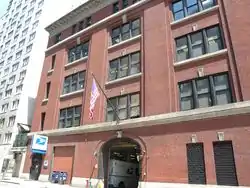
Murray Hill is located in two primary ZIP Codes. The area south of 40th Street is located in 10016, while the area north of 40th Street is in 10017. There are also three smaller ZIP Codes for individual buildings: 10158 (605 Third Avenue), 10165 (One Grand Central Place), and 10168 (Chanin Building).[61] The United States Postal Service operates three post offices in Murray Hill:
Education
Murray Hill and Stuyvesant Town generally have a higher rate of college-educated residents than the rest of the city as of 2018. A majority of residents age 25 and older (82%) have a college education or higher, while 3% have less than a high school education and 15% are high school graduates or have some college education. By contrast, 64% of Manhattan residents and 43% of city residents have a college education or higher.[38]:6 The percentage of Murray Hill and Stuyvesant Town students excelling in math rose from 61% in 2000 to 80% in 2011, and reading achievement increased from 66% to 68% during the same time period.[65]
Murray Hill and Stuyvesant Town's rate of elementary school student absenteeism is lower than the rest of New York City. In Murray Hill and Stuyvesant Town, 8% of elementary school students missed twenty or more days per school year, less than the citywide average of 20%.[39]:24 (PDF p. 55)[38]:6 Additionally, 91% of high school students in Murray Hill and Stuyvesant Town graduate on time, more than the citywide average of 75%.[38]:6
Schools

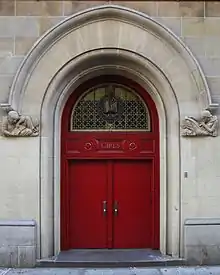
The New York City Department of Education operates local public schools. P.S. 116, Mary Lindley Murray School, is the neighborhood elementary school.[12][66] The entrances to P.S. 116 on 33rd Street are divided into "Boys'" and "Girls'" doors. Each entrance features decorative carvings of male and female students, respectively, engaged in reading and scientific activities.
Murray Hill residents are also zoned to I.S. 104, the Simon Baruch School, located in the Gramercy Park neighborhood.[67]
Libraries and higher education
The New York Public Library (NYPL)'s Kips Bay branch is located at 446 Third Avenue. The one-story branch opened in 1972 as a replacement for the St. Gabriel's and Nathan Straus branches.[68]
The community is also home to the CUNY Graduate Center, which shares the former B. Altman & Company Building with Oxford University Press.
Transportation
Murray Hill is served by the New York City Subway's 6 and <6> trains at 33rd Street. It is also served by MTA Regional Bus Operations' M15, M15 SBS, M34 SBS, M34A SBS, M101, M102 and M103 routes. Metro-North Railroad service is available at nearby Grand Central Terminal.[69]
Murray Hill is served by various NYC Ferry and SeaStreak ferry services at the East 34th Street Ferry Landing.[70] The ferry landing is adjacent to the East 34th Street Heliport.
Telephone exchange
For the most part of the 20th century the name "Murray Hill" was used by New York Telephone as a telephone exchange for residents living on the East Side of Manhattan, served from the East 37th Street exchange building. Though the entire city was covered by area code 212 until the 1980s, most neighborhoods at the time would be grouped together by a particular exchange name. Other municipalities in the United States would also use MUrray or MUrray Hill as an exchange name. The first two letters in MUrray (capitalized to indicate that they should be dialed) would be followed by five digits to make up a telephone number, such as MUrray Hill 5-9975 (the Ricardos' number on I Love Lucy). This was the way most telephone numbers were given until AT&T switched to All-Number Calling by the late 1970s to early 1980s. Nevertheless, the name MUrray Hill is still applicable, as many East Side phone numbers in area code 212 still begin with 68, which corresponds to MU on the telephone keypad.
See also
- Robert Murray (merchant) (1721–1786)
- Lindley Murray (1745–1826)
References
Notes
- "NYC Planning | Community Profiles". communityprofiles.planning.nyc.gov. New York City Department of City Planning. Retrieved March 18, 2019.
- "Murray Hill neighborhood in New York". Retrieved March 18, 2019.
- Table PL-P3A NTA: Total Population by Mutually Exclusive Race and Hispanic Origin - New York City Neighborhood Tabulation Areas*, 2010, Population Division - New York City Department of City Planning, March 29, 2011. Accessed June 14, 2016.
- Gregor, Alison (August 13, 2014). "Murray Hill for Family Living". The New York Times. ISSN 0362-4331. Retrieved December 1, 2015.
Murray Hill runs from 40th Street down to about 27th Street, and from Fifth Avenue over to the East River, according to the neighborhood association.
- The Murray Hill Neighborhood Association - About Us
- Alfred Pommer & Joyce Pommer (2013). Exploring Manhattan's Murray Hill. The History Press.
The Murray Hill Farm (Belmont) ran from today's East 34th Street to East 40th Street and from Madison Avenue to Third Avenue. The Murray Hill Neighborhood (postal district) runs from East 27th Street to East 40th Street and from Fifth Avenue to the East River. The Murray Hill Historic District is located along parts of East 35th Street, East 36th Street, East 37th Street and East 38th Street.
- https://macaulay.cuny.edu/seminars/gardner-indian/articles/m/u/r/Murray_Hill_b037.html
- "Little Armenia, New York". The Armenite. March 17, 2014. Retrieved March 29, 2020.
- White, Norval & Willensky, Elliot (2000). AIA Guide to New York City (4th ed.). New York: Three Rivers Press. ISBN 978-0-8129-3107-5.
- Cheslow, Jerry (December 5, 1999). "If You're Thinking of Living In / Murray Hill; A Quiet Enclave Close to Midtown". The New York Times. Retrieved January 12, 2008.
- Jeff Vandam (April 17, 2009). "Living In / A Lot to Soak Up, Even Outside the Bars". The New York Times.
- Shown on a detail of the British Headquarters map, c. 1781 in Sanderson 2009, p. 55, fig. a. The orchards are shown behind the house to the north.
- Muschamp, Herbert (December 5, 1997). "Critic's Notebook; Atop a Hill In Midtown, Where Life Is a Stroll". The New York Times. Retrieved July 1, 2008.
- L.P. Gratacap, Geology of the City of New York (New York, 1904), quoted in Sanderson 2009, appendix A p. 252.
- See for some examples Richmond Hill, the Apthorp Farm, the Morris-Jumel Mansion, Gracie Mansion, and Alexander Hamilton's "Grange"
- Burrows & Wallace 1999, p. 179.
- Plying them with cakes and wine in earlier tellings, as reported in Burrows & Wallace 1999, p. 241.
- McCullough, David. "1776", p. 216. "In explanation, a romantic story spread - a story that would become legendary - that a Mrs. Robert Murray, a Quaker and an ardent patriot, had delayed William Howe and his generals by inviting them to afternoon tea at her country home at Inclenberg, later known as Murray Hill."
- "TOWER SITE PART OF $2,400 FARM; 20-Acre Tract in 1799 Was the Scene of Fights With British-- Sold for $10,000 in 1805" (PDF). The New York Times. May 2, 1931. ISSN 0362-4331. Retrieved October 23, 2017.
- Thacher, James (1854). Military Journal, During the American Revolutionary War, from 1775 to 1783. Silas Andrus & Son. pp. 494.
- Kadinsky, Sergey (2016). Hidden Waters of New York City: A History and Guide to 101 Forgotten Lakes, Ponds, Creeks, and Streams in the Five Boroughs. Countryman Press. pp. 26–28. ISBN 978-1-58157-566-8.
- Burrows & Wallace 1999, p. 412.
- Sanderson 2009, pp. 81, map "Fill and Excavation, 1609–2009".
- Joseph Brennan (Columbia University) "Abandoned Stations: 38 St."
- Burrows & Wallace 1999, p. 717.
- "In the no longer cutting-edge Murray Hill" (Burrows & Wallace 1999, p. 1075).
- placematters.net
- Berger, Joseph (January 18, 2011). "In Murray Hill, the College Life Need Never End". The New York Times. Retrieved January 19, 2011.
- Holusha, John (February 17, 1999). "Con Ed Plans To Sell 3 Lots Near the U.N." The New York Times. ISSN 0362-4331. Retrieved April 17, 2019.
- Bagli, Charles V. (August 19, 2013). "Prime Lot, Empty for Years (Yes, This Is Manhattan)". The New York Times. ISSN 0362-4331. Retrieved April 17, 2019.
- Dunlap, David W. (January 26, 2017). "Building to the Sky, With a Plan for Rising Waters". The New York Times. ISSN 0362-4331. Retrieved April 17, 2019.
- Rosenberg, Zoe (April 6, 2018). "Sheldon Solow's empty east side site will gain 3 more condos, biotech office space". Curbed NY. Retrieved April 17, 2019.
- Hughes, C. J. (April 6, 2018). "A Real Estate Dynasty Passes the Torch". The New York Times. ISSN 0362-4331. Retrieved April 17, 2019.
- New York City Neighborhood Tabulation Areas*, 2010, Population Division - New York City Department of City Planning, February 2012. Accessed June 16, 2016.
- Table PL-P5 NTA: Total Population and Persons Per Acre - New York City Neighborhood Tabulation Areas*, 2010, Population Division - New York City Department of City Planning, February 2012. Accessed June 16, 2016.
- "Stuyvesant Town and Turtle Bay (Including Beekman Place, Gramercy Park, Murray Hill, Stuyvesant Town, Sutton Place, Tudor City and Turtle Bay)" (PDF). nyc.gov. NYC Health. 2018. Retrieved March 2, 2019.
- "2016-2018 Community Health Assessment and Community Health Improvement Plan: Take Care New York 2020" (PDF). nyc.gov. New York City Department of Health and Mental Hygiene. 2016. Retrieved September 8, 2017.
- "New Yorkers are living longer, happier and healthier lives". New York Post. June 4, 2017. Retrieved March 1, 2019.
- "NYC-Manhattan Community District 6--Murray Hill, Gramercy & Stuyvesant Town PUMA, NY". Retrieved July 17, 2018.
- "Discover New York City Landmarks". New York City Landmarks Preservation Commission. Retrieved December 21, 2019 – via ArcGIS.
- "Company Profile." L3 Technologies. Retrieved on March 10, 2010.
- "Office Network Archived February 1, 2009, at the Wayback Machine." Sumitomo Corporation. Retrieved on January 25, 2009.
- "Flatiron / Gramercy / Murray Hill / Union Square: Manhattan Neighborhood Map." About.com. Retrieved on January 25, 2009.
- "Branch Offices North America Archived November 28, 2011, at the Wayback Machine." China Airlines. Retrieved on January 25, 2009.
- World Airline Directory. Flight International. March 20, 1975. "472.
- Sterba, James P. "American Will Shift Headquarters From Manhattan to Dallas Airport; Big Economies Predicted." The New York Times. Thursday November 16, 1978. Page A1. Retrieved on August 27, 2009.
- Home Page Archived February 27, 2009, at the Wayback Machine." Consulate-General of Mexico in New York. Retrieved on January 25, 2009.
- Home Page." Consulate-General of South Africa in New York. Retrieved on January 26, 2009.
- "Consulate General of the Republic of Poland in New York". Konsulat Generalny Rzeczypospolitej Polskiej w Nowym Jorku. July 2, 2019. Retrieved July 13, 2019.
- "United Nations Member States." United Nations. Retrieved on January 26, 2009.
- Home page. Permanent Mission of the People's Republic of China to the United Nations. Retrieved on January 26, 2009.
- "NYPD – 17th Precinct". www.nyc.gov. New York City Police Department. Retrieved October 3, 2016.
- "Murray Hill and Gramercy – DNAinfo.com Crime and Safety Report". www.dnainfo.com. Archived from the original on April 15, 2017. Retrieved October 6, 2016.
- "17th Precinct CompStat Report" (PDF). www.nyc.gov. New York City Police Department. Retrieved July 22, 2018.
- "Engine Company 21". FDNYtrucks.com. Retrieved March 14, 2019.
- "FDNY Firehouse Listing – Location of Firehouses and companies". NYC Open Data; Socrata. New York City Fire Department. September 10, 2018. Retrieved March 14, 2019.
- "Manhattan Hospital Listings". New York Hospitals. Retrieved March 20, 2019.
- "Best Hospitals in New York, N.Y." US News & World Report. July 26, 2011. Retrieved March 20, 2019.
- "Murray Hill, New York City-Manhattan, New York Zip Code Boundary Map (NY)". United States Zip Code Boundary Map (USA). Retrieved March 23, 2019.
- "Location Details: Murray Hill". USPS.com. Retrieved March 7, 2019.
- "Location Details: Murray Hill Annex". USPS.com. Retrieved March 7, 2019.
- "Location Details: Tudor City". USPS.com. Retrieved March 7, 2019.
- "Stuyvesant Town/Turtle Bay – MN 06" (PDF). Furman Center for Real Estate and Urban Policy. 2011. Retrieved October 5, 2016.
- "P.S. 116 Mary Lindley Murray School." Insideschools.org. Retrieved on January 25, 2009.
- "School Search" New York City Department of Education. Retrieved on January 25, 2009
- "About the Kips Bay Library". The New York Public Library. Retrieved March 23, 2019.
- "Manhattan Bus Map" (PDF). Metropolitan Transportation Authority. July 2019. Retrieved December 1, 2020.
- "East 34th Street/Midtown East Landing". New York City Ferry Service. Retrieved March 23, 2019.
Sources
- Burrows, Edwin G. & Wallace, Mike (1999). Gotham: A History of New York City to 1898. New York: Oxford University Press. ISBN 0-195-11634-8.
- Sanderson, Eric (2009). Mannahatta: A Natural History of New York City. Harry N. Abrams. ISBN 978-1-4197-0748-3. Retrieved December 10, 2017.
Further reading
- Gregor, Alison (August 13, 2014). "Murray Hill for Family Living". The New York Times. ISSN 0362-4331. Retrieved December 1, 2015.
- Lagorio, Christine (November 18, 2004). "Close-Up on Murray Hill". Village Voice. Retrieved January 27, 2006.
- Monaghan, Charles (May 1996) "Lindley Murray and the Enlightenment" Paradigm